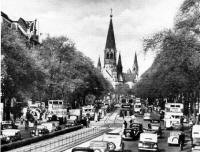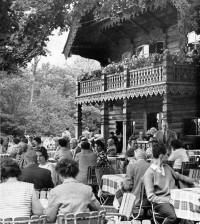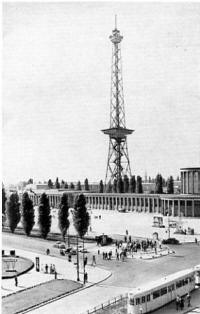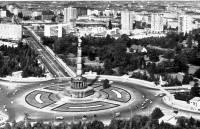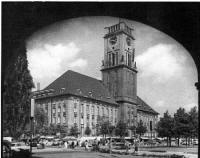From the Files of John & Johanna Lawler (64-66)
From the AF
Pamphlet Entitled"Tempelhof Central Airport
Berlin, Germany"
The City of Berlin
Berlin, the largest city in Germany, comprises an area of 341 sq. miles (West Berlin-186 sq. m.; East Berlin-155 sq. m.) and a population of some 3.3 million (2.2 million are in West Berlin and 1.1 million in East Berlin). Greater Berlin covers an area larger than that of Washington and Paris combined. It is divided between the Soviet East and the American, British and French controlled West Sectors. West Berlin is surrounded by the Soviet-sponsored East German Democratic Republic and is approximately 110 miles from the West German border city of Helmstedt. It is 247 air miles from Rhein/Main Air Base at Frankfurt/Main, Germany. Situated as it is on the boundary between East and West, Berlin has attained a unique and highly interesting position in international politics.INTRODUCTION
In addition to Berlin's location, the city is a world-renowned cultural center and the site of international exhibitions, conventions, and festivals. West Berlin also provides a multitude of opportunities for sightseeing, shopping, sports, concert-going and night clubbing.
CLIMATE
West Berlin lies in the same geographical position as Labrador. The winters, however, are not as severe. The winter climate is comparable to Baltimore and Washington, D. C. There is considerable rainfall the year round and at times heavy fog makes automobile travel hazardous. The average summer temperature is 72 while the annual average is 48 degrees.AMUSEMENTS
Berlin has a multitude of amusements to suit the taste of everyone. One can choose from a variety of amusements like sports or exhibitions every night. Moreover, over 5000 restaurants can be found in West Berlin alone.CULTURAL ATTRACTIONS
Berlin is renowned for its cultural attractions. In addition to the West Berlin opera and the Philharmonic orchestra, Berlin has 12 theatres. The standard of present-day productions is worthy of Berlin's greatest theatrical epoch and includes the work of classical and modern symphonies, operas and ballets with something to suit the taste of everyone. West Berlin also has 16 museums and exhibitions which hold world-famous examples of art.HISTORY
When the two villages of Koelln and Berlin were founded near the confluence of the Spree and Havel Rivers in 1237, it could not be foreseen that they would merge to form the nucleus of one of the giant cities of Europe and the ninth largest city in the world today.During its first 500 years of existence, the city's growth was slow and somewhat fluctuating. Prosperity came early with the two cities admitted to the Hanseatic League in 1359. A political boost occurred in 1415 when Frederick of Hohenzollern was invested with the Mark of Brandenburg (a political title of the state). There ensued the merger of Koelln and Berlin in 1432 and the expansion to include the neighboring villages of Tempelhof, Mariendorf, Marienfelde and Rixdorf.
In 1470, Frederick II, Elector of Brandenburg, chose Berlin for his official residence in the Mark. The 16th century was also a prosperous, but no booming one, for the fledgling capital. It established firm economic ties with the rest of Germany which was then a hodge-podge of 60-odd states and free municipalities.
But her growth suffered a severe setback in the 17th century with the outbreak of the Thirty Years' War and several plagues that left the capital with a greatly reduced population. Small numbers of immigrants, however, began to fill in the gaps left by disaster and by 1700, the population hovered around the 54,000 mark. Among these immigrants were 20,000 French Huguenots who were offered asylum in the city by Frederick William, the "Great Elector." This proved to be Berlin's first industrial boom as they brought along their varied crafts and skills. For example, the city's vast textile industry had its beginnings during this period.
Through immigration and increase in the birth rate, the city tripled its population in the next 100 years, but still ranked comparatively low among European population centers. Under Frederick the Great, the city became the industrial center of Prussia. The emperor also patronized the arts, science and trade which signaled Prussia's rise as a great power. Artists, philosophers and other creative minds flocked to the city to transform it into the "Athens of the North."
The 19th century and the onrushing tide of the industrial revolution promised a great future for Berlin with its central location near major land and river arteries. Canal building continued at a furious pace which linked the capital by water to almost every other metropolitan area in Germany. As a result, Berlin became a large trading center. Then came the railroads which strengthened its economic supremacy among the German states.
At the time of Bismarck's accession in 1862, we note that the population has cleared the 600,000 figure. The next 30 years witnessed one of the most incredible municipal population explosions in the history of the world as the city quadrupled to 2,700,000. By this time, Berlin had become the dominant political focus of the new Germany displacing the old-established centers in the Rhinelands. Now it could challenge London for European leadership. In 1910, the census takers counted another one million people.
The resulting discontent and inflation brought on by defeat in World War I did not curb the city's growth. The outlying areas of Spandau, Zehlendorf and other suburbs were incorporated which brought over 300,000 people into the fold in 1920. By 1939, Berlin was the world's fifth largest city, trailing London, New York, Tokyo and Shanghai with 4,330,000 people.
Berlin suffered extreme damage in World War II. From the sound of the first air raid siren, the capital received almost continual punishment from the air. The arrival of the Russian Army in March, 1945, brought more devastation. After the war 60 per cent of the rubble in Germany was found in the city. Today the three highest points in the city - Teufelsberg, Insulaner and Hasenheide - are hills made up of the debris.
But the West Berliners remained undaunted by the devastation of the past and point with pride to their industrial recovery, and to their future. Today, the industrial production of Berlin is greater than its high point of 1939.
ASSIGNMENT BERLIN
Reproduced from THE AIRMAN
April, 1962
For many months, headlines have focused attention on the divided city of Berlin. Items such as "Russian Tanks Face Americans at Friedrichstrasse" or "Man Shot While Swimming Canal" are read by millions of people throughout the world. Certainly news of this type is not calculated to relax nerves already taut with tensions of a seemingly interminable cold war. And undoubtedly many of you in uniform have wondered, and perhaps been a trifle apprehensive, about an assignment in Berlin. You need not be, because the several hundred Air Force personnel who work and play in this dramatic setting actually live fairly normal Air Force lives.
First of all, the widespread belief that it is difficult to travel in and out of the city simply is not true. Travel restrictions may be inconvenient at times, but not difficult. There are three approved methods for servicemen and their families to travel in and out of Berlin. The forces of Great Britain, France and the U. S. have access rights via three air corridors which begin at Frankfurt, Hannover and Hamburg. Each one is 20 statute miles wide and terminates in a circular zone with a diameter of 20 miles centered on the Air Safety Center in downtown Berlin. Military and commercial fleets of the United States, France and Great Britain have the right to use these routes.
A second method involves duty trains which run daily between Berlin, Frankfurt, and Bremerhaven. To travel by this method, you must have competent orders plus a Russian translation which is obtained from American authorities at either end of the line. At Marienborn, a few miles from the Helmstedt border crossing, the train stops and Russian soldiers are handed your papers for examination. At no time do the Russians board the train. Still another, and perhaps more interesting method, is to drive down the Autobahn which extends some 110 miles from Helmstedt to the outskirts of the city. Here again, you need orders and a Russian translation. When you arrive at the checkpoint, and there is one at each end, a Russian soldier motions you to the head of the line. After a cursory examination of your papers, he directs you to a small building. Upon entering this structure, you knock at a tiny window and, speakeasy style, it is opened by a Russian officer who takes your orders. Some minutes later, the window opens, a hand gives you your documents and you are on your way. The procedure is repeated at the other end.
The Funkturm (radio tower) is the second tallest structure in Berlin. It stands 455 feet high and has an observation platform near the top and a restaurant at the 180-foot level. At its base are the Exhibitiona and Fair Grounds, with 13 acres of inclosed halls and pavilions and 30 acres of open-air exhibition space.
Nearby is the 220-foot Siegessaeule (Victory Column), topped with a gilt statue of the Goddess of Victory. It is located in the middle of the Tiergarten, a beautiful park in pre-war Berlin but almost completely destroyed during and immediately following the war. Replanting was begun in 1949.
The Congress Hall is one of the boldest designs to be found in modern architecture. It was donated to Berlin by the United States. Its roof consists of two tremendous concrete arches, each weighing 600 tons, which seem to hover in the air.
At Tempelhof Central Airport, a new arrival is confronted with a gigantic arc-shaped building that is 7/10 mile long on the airfield side alone. This building, started in the 1930s by Adolf Hitler, was supposed to house the offices of Lufthansa on the most modern airport in the world. It never was completely utilized and construction on it ceased in 1943. Finally, after the Russians set fire to it in 1945, it was taken over by American forces in July of the same year, and since that time it has been repaired. Now the Air Force controls 60 per cent of it-some 2,500 rooms, and the Berliner Flughafen Gesellschaft the rest.
Although never destined to realize its purpose, the entire roof of the hangar was laid in tiers to form a semi-circular stadium, which was designed to seat thousands of spectators for air and ground demonstrations. The roof still shows evidence of plans for a large open-air-restaurant, public telephones and rest rooms. It also provides Tempelhof Central Airport with an overhang of some 1,400 feet, 39 feet high and 120 feet deep which permits offloading of large aircraft out of the weather. The bulk of the offices utilized by the Air Force are in the building and in the annexes that run off the main stem.
The responsibility for running TCA rests on the shoulders of the commander of the 7350th Support Group. Specifically, the mission of this unit is to operate an aerial port of entry into Berlin and provide the administrative and logistical services for assigned, attached and tenant units including a few U.S. Army organizations. Also, the commander of the 7350th Support Group is the USAFE representative in the Berlin area.
Three airlines operate out of TCA, with the French normally having only one cargo flight a day since the bulk of their flights come out of Tegel, which has a runway long enough to handle Caravelle jets. Some 4,000 landings and takeoffs a month are normal. About 500 of them are Air Force aircraft. As far as the USAF is concerned, only two T-29's are permanently stationed here and are flown by personnel of all units at TCA.
An assignment to Tempelhof is interesting from several standpoints. Factors to consider are the location and political situation, the people you meet and work with, and the city itself.
Of course, the location of Tempelhof, some 110 miles behind the Iron Curtain, makes any assignment here interesting. Anytime that you drive a car, you are constantly reminded of where you are by the fact that sooner or later you will bump into a wall or a fence. And anytime you see jet contrails overhead, they are Russian, not ours. As you know, prior to Aug. 13, 1961, there were no physical barriers between East and West Berlin. Now a 28-mile wall, "Die Mauer" as the Germans call it, divides the Soviet sector from West Berlin. Ugly in appearance and spirit, it cuts the refugee flow which had reached the staggering proportions of 2,000 a day before East Berlin was sealed off. Now seven crossings, just barely wide enough to admit a bus, are maintained by the communists. West Germans may cross at two points and West Berliners at four, one for all foreigners at Friedrichstrasse completes the picture.
At present, Americans in uniform may enter into East Berlin. The border guards stare at you and let you pass. In addition, some 74 miles of wall and double rows of barbed wire seal off the boundaries of the GDR from the rest of Berlin. Because of the proximity of communism, an airman stationed here has an excellent chance to view the work and the results of a totalitarian regime in action. Each day the papers, both East and West, are crammed with opposing viewpoints regarding the political situation. Each day, some refugees still make a hazardous crossing, and each day you know you are in a place that demands world attention. From time to time you may have some reason to drive through East Germany down the Autobahn or to visit East Berlin. In each instance, you can see the grimness of the people reflected in their attitude. Moreover, when, and if, there is no chance of being observed, most of the people on the other side will wave to you or indicate their feelings of friendliness toward the U. S.
The people you meet and work with also contribute to the assignment here. Depending on your job and the social functions you attend, you meet people from the U. S. Army, British, French and, from time to time Russian armed services. In addition, you have contacts with officials of the Berlin city government. Because of the political situation today, many people do not realize that we still cooperate with the Russians in several areas. For example, the Air Safety Center, located in downtown Berlin, has Air Force members of all four occupying powers. Here the Russian officers initial flight plans which indicate that they are aware of the presence of Allied aircraft in one of the air corridors.
The Allied Travel Office, located in the same building, grants travel documents to citizens of the so-called German Democratic Republic for travel in Britain, France, or the United States and other NATO countries, which do not recognize the GDR. Since August 13, business has declined.
Perhaps the best known example of four-power cooperation still in existence is Spandau Prison, located in the British sector, where Rudolf Hess, Baldur von Schirach, and Albert Speer are still held for war crimes. The guard changes once a month. Of course, we have many more contacts with our French and British counterparts, often on a daily basis. Moreover, many of the great and near great enter Berlin via Tempelhof. Press conferences, honor ceremonies, and the bustle that attends the arrival and departure of distinguished visitors are commonplace on the ramp at Tempelhof Central Airport. Again depending on your job, you many have the opportunity to meet some famous people in person.
The Schoeneberg Rathaus (West Berlin City Hall) is the seat of the West Berlin city government. In its tower is the Freedom Bell, a gift to Berlin from 17 million Americans.
And then there is Berlin itself! Areawise, it is one of the largest cities in the world measuring some 341 square miles in the manner of Los Angeles. Indeed, Washington and Paris can fit in Berlin with room to spare. Of this area, 186 square miles is in the Western sectors with 155 square miles on the Soviet side. Forest, parks, and water cover 49 square miles of the "city in the country." Some 3,300,000 people live here. 2,200,000 on the West side alone. Thus, Berlin has all of the attractions of a large cosmopolitan area.
If you are planning an evening out, you can start with dinner at one of 6,000 restaurants. Depending on your taste, you can then attend any of a multitude of sports attractions, the opera, one of several concerts, or a theater performance. In addition, museums, castles, and points of interest abound. And, above all, prices are more reasonable than in most cities in Europe.
Berlin is also a beautiful city. Even though some ruins are still in evidence, age has softened their harsh appearance. From the forest in the Grunewald, to the Wannsee on the Havel River, to the bright lights of the Kurfuerstendamm, Berlin has earned the title, "Once seen, forever loved!"
Despite the crises over Berlin, Air Force personnel and their families enjoy relatively routine living. The housing area run by the U. S. Army, is one of the finest in Europe, and the support facilities are excellent. All of the varied activities that you would expect at any base in the U.S. are found here. Dependents are, as a rule, not nervous about being here. Actually, letters and papers from home cause more excitement vis-a-vis the Berlin situation than the people stationed here feel is justified. Indeed, most people feel that Berlin is one of the finest tours in the world.
The average airman in Berlin knows that he is fulfilling a vital task in maintaining the freedom of 2,200,000 West Berliners and, ultimately, the entire Free World. Because he is the representative of more than 193,000,000 Americans, his responsibilities go far beyond the scope of his daily job. Indeed his actions are carefully scrutinized by Berliners, both East and West, for the communists are quick to enlarge on the frailties of human nature. The ideas represented by the American airmen cannot be shut out by a wall.
The continued presence of American airmen and their dependents constitute a visible guarantee to Berlin and the western world, that the United States is willing to stand for freedom. This then, is assignment Berlin.
Lawler "Welcome to Berlin" Memento Page
Mementos Page
